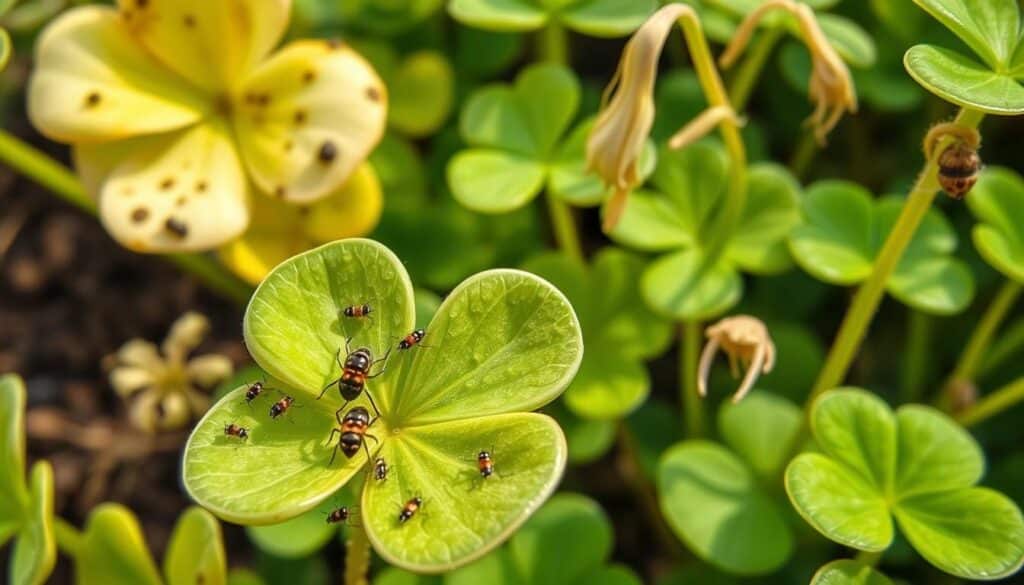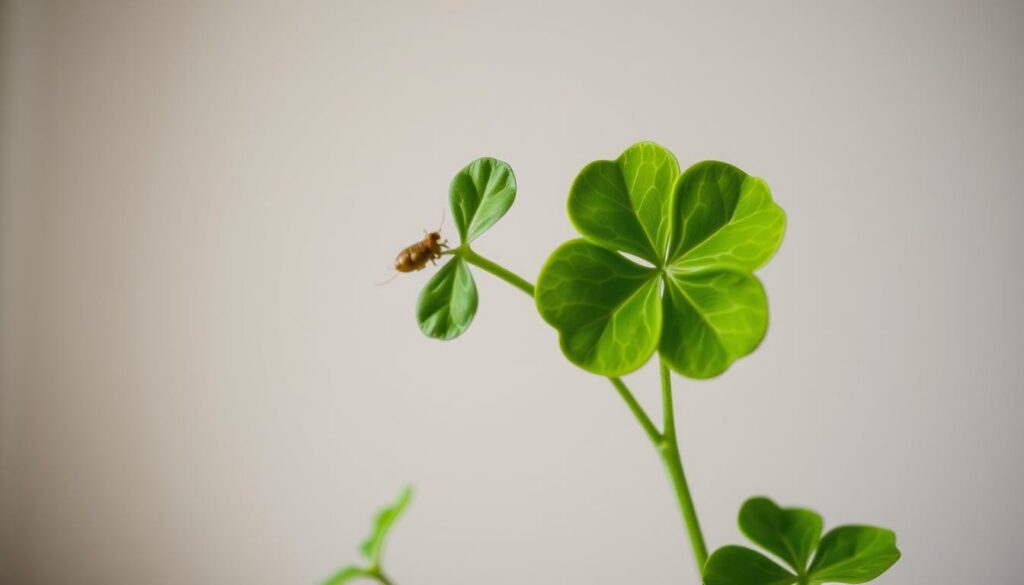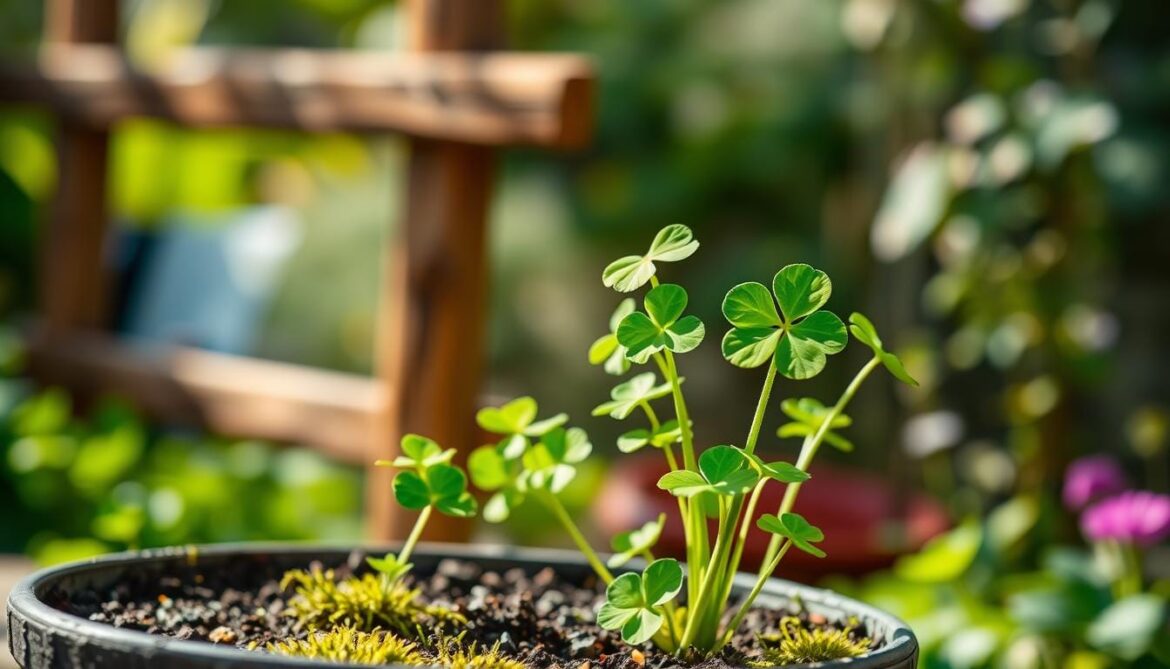Seeing a shamrock plant’s heart-shaped leaves on my grandmother’s windowsill was magical. Those green clusters, full of luck and charm, made me want to learn how to care for them. Now, I’m excited to share that journey with you.
Whether you’re new to gardening or have years of experience, this guide is for you. It will help you grow shamrock plants that bring joy all year long.
Key Takeaways
- Discover essential shamrock plant care tips for healthy growth.
- Learn how to care for shamrock plant through simple, step-by-step advice.
- Understand ideal conditions for indoor and outdoor cultivation.
- Identify common issues like yellowing or wilting leaves and solutions.
- Explore varieties like Oxalis triangularis and Oxalis regnellii.
Introduction to the Shamrock Plant
The shamrock plant, also known as Oxalis, is known for its unique three-part leaves. It comes from places like Ireland, where it’s seen as a symbol of luck and heritage. Its heart-shaped leaves remind people of St. Patrick’s teachings, setting it apart from other plants like common clover.
True shamrock plant varieties are part of the Oxalis family, not the Trifolium genus. Its leaves fold down at night and go back up in the morning, a cool trick called nyctinasty. This shows it’s a living clock that follows the day and night cycle. It thrives in both indoor and outdoor spaces, thanks to its adaptability.
Even though it’s tied to Irish traditions, its appeal goes beyond Ireland. Its bright colors and deep meanings make it a favorite among gardeners. They love its ability to survive and the wide range of leaf colors, from green to purple. This mix of cultural importance and botanical interest makes it a top pick for garden lovers.
Types of Shamrock Plants
Shamrock plant varieties offer a wide range of choices for gardeners. These plants, famous for their unique leaf shapes, do well in many settings. A detailed guide explains their special features. Let’s look at three notable varieties.
Oxalis Triangularis
This variety, also known as the Purple Shamrock, has deep purple leaves and delicate pink or white flowers. Its heart-shaped leaves add a dramatic flair to indoor spaces. It prefers indirect light and moist soil. It’s perfect for shamrock plant lovers who want bold color contrasts.
Oxalis Regnellii
The Green Shamrock has classic three-leaf clovers and small white flowers. Its compact size is great for small pots. Unlike some, it does well in partial shade. With the right care, it stays evergreen.
Oxalis Deppei
Known as Iron Cross for its distinctive leaf bases, this variety has upright stems and lavender-pink flowers. It can handle drought better than others. Its striking leaf patterns make it a standout in any plant collection.
Ideal Growing Conditions for Shamrock Plants
Shamrock plants do best in the right environment. Knowing their light, soil, and temperature needs helps them stay healthy. Follow these shamrock plant care tips to create the perfect setup.
Sunlight Requirements
Shamrock plants need bright, indirect light. Place them near east- or north-facing windows for the best growth. Avoid direct afternoon sun, as it can burn their leaves. Signs of too much light include faded or curled leaves.
- Provide 6-8 hours of filtered light daily.
- Rotate plants weekly to ensure even growth.
- Use sheer curtains to diffuse harsh sunlight.
Soil Preferences
Shamrocks need well-draining soil to prevent root rot. Use a mix of peat moss, sand, and compost for indoor plants. Commercial mixes for African violets also work well. Avoid heavy soils that hold too much moisture.
Temperature Needs
These plants prefer temperatures between 60–75°F (15–24°C). Keep them away from heating vents or drafty windows. Sudden drops below 55°F (13°C can slow their growth.
By meeting these conditions, shamrock plants reward gardeners with lush foliage and blooms. Regular checks on light, soil, and warmth keep them thriving all year.
Planting Shamrock Plants
Starting with the right how to care for shamrock plant begins with planting. The timing and method are key for healthy growth. Whether you’re starting with bulbs or transplanting, knowing when and how to plant is vital for thriving shamrocks.

“Proper planting sets the foundation for vibrant blooms and robust foliage,” advises Chikus Garden.
When to Plant
Plant shamrock bulbs in early spring when the soil is 60–70°F. Don’t plant during their dormant period, from late summer to early winter. Make sure the bulbs are firm and disease-free. This timing matches their natural growth cycle for the best results.
How to Plant
- Choose pots with drainage holes to prevent root rot. Use well-draining soil mixes.
- Bury bulbs 2–3 inches deep, spaced 4–6 inches apart in groups of 3-5.
- Water thoroughly after planting. Allow soil to dry slightly between waterings.
- Mulch lightly to retain moisture and regulate temperature.
Repotting shamrock plant every 2-3 years is essential as roots outgrow containers. Use fresh soil and gently loosen tangled roots before transferring. After repotting, place in indirect light and reduce watering until new growth appears. Watch for signs of shock like wilting, and adjust care practices as needed.
Watering Guidelines
Proper shamrock plant watering is key to their health. Follow these steps to avoid mistakes and keep your plant thriving. Maintaining the right soil moisture is essential for how to care for shamrock plant effectively.
Shamrocks need consistent but not too much moisture. Here’s how to adjust your watering based on their needs.
Frequency of Watering
- Check the soil: Water when the top inch feels dry to the touch.
- Seasonal adjustments: Reduce watering in winter when growth slows.
- Use room-temperature water to avoid shocking roots.
Signs of Overwatering
- Yellowing leaves, specially lower ones.
- Mushy stems or a musty smell (root rot).
- Fungal growth on soil surface.
Signs of Underwatering
- Wilting that doesn’t recover after watering.
- Crispy leaf edges or brown tips.
- Leaves dropping prematurely.
| Issue | Overwatering Symptoms | Underwatering Symptoms |
|---|---|---|
| Leaf Condition | Yellow, spotted leaves | Brown, crispy edges |
| Stem Health | Mushy or soft stems | Brittle, dry stems |
| Soil Texture | Soggy or moldy soil | Dry, cracked soil |
Fertilizing Your Shamrock Plant
Feeding your shamrock plant right is key. It helps keep the leaves green and flowers bright. Here’s how to pick the best nutrients and when to use them.

Types of Fertilizers
| Type | NPK Ratio | Pros | Cons |
|---|---|---|---|
| 10-10-10 Liquid | 10-10-10 | Quick absorption, easy mixing | Requires monthly applications |
| Slow-Release Granules | 14-14-14 | Lasts 3-4 months, convenient | Potential salt buildup |
| Organic Compost Tea | 3-4-3 | Enriches soil structure | Less immediate results |
Always water down liquid fertilizers to half-strength. This prevents burning the leaves. Steer clear of too much nitrogen, as it favors leaves over flowers.
When to Fertilize
- Start in spring when leaves emerge
- Fertilize every 4-6 weeks during active growth (March–October)
- Stop feeding by November to prepare for dormancy
Don’t overdo it—use half the amount recommended for how to care for shamrock plant roots. Soil tests can help figure out what your plant needs.
Pruning and Maintenance
Regular pruning and maintenance are key shamrock plant care tips. They keep your plant lush and full of life. By using the right techniques, your plant will stay healthy and free of dead parts.
Importance of Pruning
Removing dead or yellow leaves stops diseases from spreading. It also helps your plant grow new leaves. Pruning also makes stems fuller and keeps flowers coming back longer.
Older plants need trimming to avoid becoming too tall. This can weaken the plant’s structure.
How to Prune
- Clean tools: Use sharp scissors or shears to avoid crushing stems.
- Cut yellow leaves at their base, near the soil line.
- Deadhead spent blooms to redirect energy to new buds.
- Trim leggy stems by one-third their length to promote branching.
Follow these how to care for shamrock plant tips every week. Clean leaves with a damp cloth to remove dust. Also, rotate pots for even light.
Tall plants might need stakes for support. For outdoor plants, check out Chikus Garden’s guide for ivy care. It has great ideas for your garden.
Pests and Diseases
Shamrock plant care tips must address pests and diseases. Regular checks are vital to protect these plants. 
Common Pests Affecting Shamrock Plants
| Pest | Signs | Organic Solutions | Chemical Options |
|---|---|---|---|
| Aphids | Small insects on stems/leaves; sticky residue | Wipe with soapy water; introduce ladybugs | Insecticidal soap |
| Spider Mites | Yellow speckles; webbing | Rinse leaves with water | Acetamiprid spray |
| Mealybugs | White cotton-like clusters | Alcohol swabs to remove | Neem oil |
| Scale Insects | Hard bumps on stems | Scrape off manually | Systemic insecticide |
Recognizing Diseases
- Powdery Mildew: White powdery coating on leaves. Improve air circulation and use sulfur-based fungicide.
- Leaf Spot: Brown spots with yellow halos. Remove infected leaves and avoid overhead watering.
- Root Rot: Wilting despite moist soil. Repot in fresh, well-draining soil.
Prevention starts with proper care for shamrock plants. Isolate new plants for two weeks. Clean tools and avoid overwatering. Early detection stops issues from spreading. Consistent care ensures healthy growth.
Propagation Methods for Shamrock Plants
Propagating shamrock plants is easy and fun. The best way is to divide the rhizomes or tubers when repotting shamrock plant in early spring. Start by carefully taking the plant out of its pot and looking at the roots. Healthy tubers can be split into separate groups, each with a growth bud.
Make sure to use new pots with fresh soil for each division. This helps the new plants grow well.
Here’s how to divide:
- Take the plant out of its pot and shake off loose soil to see the tubers.
- Use clean shears to cut or gently separate sections with 2-3 tubers.
- Put each group in pots with drainage holes, burying tubers 1 inch deep.
- Water them a little until new shoots come out, but don’t let the soil get too wet.
Seeds are another choice, but they take longer. Collect mature seed pods and plant them in seed-starting mix. Keep the soil moist and warm for germination, which can take weeks. But, division is usually the best way to go.
After dividing, put the pots in bright, indirect light. Use clean tools during shamrock plant propagation to prevent infections. Over the next few weeks, look for new growth to see if it worked. This method lets each new plant share the parent’s qualities, perfect for growing your collection or sharing with other gardeners.
Troubleshooting Common Issues
Shamrock plant care tips often focus on prevention, but even with proper methods, issues can arise. Here’s how to address common problems quickly.

Yellowing Leaves
Yellow leaves signal stress. Check for overwatering—soil should dry 1–2 inches deep between waterings. Nutrient deficiency may require a diluted fertilizer. Move plants to brighter light if leaves fade gradually. Natural dormancy in fall/winter causes yellowing; reduce watering until growth resumes.
Wilting Leaves
Wilting isn’t always a crisis. Shamrocks fold leaves at night (nyctinasty), but persistent drooping points to drought or root rot. Water sparingly if soil is dry, but repot into fresh soil if roots smell sour. Sudden wilting after moving locations? Acclimate plants slowly to new environments.
| Issue | Possible Cause | Solution |
|---|---|---|
| Leggy stems | Low light | Relocate to brighter indirect light |
| No blooms | Incorrect temperature/light cycles | Provide 12 hours of darkness nightly during flowering season |
| Leaf drop | Temperature extremes | Maintain 60–75°F daytime temps |
Always observe plants daily. Use the how to care for shamrock plant basics first: check soil moisture, light, and temperature. Most issues resolve with adjustments to these core needs.
Seasonal Care for Shamrock Plants
Shamrock plants need care that changes with the seasons. Adjusting how much water, light, and nutrients they get helps them stay healthy all year. Here’s how to shamrock plant care tips match their natural cycles.
Spring Care Tips
- Repot in early spring if roots crowd the pot.
- Resume fertilizing with balanced liquid fertilizer every 2-3 weeks.
- Water regularly, keeping soil moist but not soggy.
- Move plants to brighter windowsills to encourage leaf growth.
Winter Care Tips
During dormancy, how to care for shamrock plant changes:
- Cut watering to once a month—let soil dry completely.
- Stop fertilizing until new growth appears.
- Place in a cool (50-60°F) room away from drafts.
For more on recognizing plant decline, see this guide on adjusting care practices.
| Season | Watering | Light | Feeding |
|---|---|---|---|
| Spring | Weekly, moist soil | Bright indirect light | Monthly fertilizer |
| Summer | Every 3-4 days | Filtered light | Half-strength fertilizer |
| Fall | Reduce to every 10 days | Dim light | Stop feeding |
| Winter | Once monthly | Low light | No fertilizer |
Indoor vs. Outdoor Growth
Shamrock plants can grow well indoors or outdoors. The choice depends on the climate, space, and how much care you can give. Here’s how to make the most of each option.
Growing Shamrocks Indoors
To grow a shamrock plant indoors, pick a spot with bright, indirect light. East- or north-facing windows are best. Don’t let direct sun hit the leaves to avoid damage.
Use pots with holes to let water drain and soil that doesn’t hold water. Keep the air around the plant humid with pebble trays or misting. Place the plant away from cold air and heaters. Their small size makes them perfect for desks, shelves, or living rooms.
- Choose clay pots for better moisture control.
- Keep soil moist but not soggy.
- Rotate plants weekly for even growth.
Growing Shamrocks Outdoors
For outdoor shamrock plant care, they do best in USDA zones 8–11. In colder areas, treat them as annuals. Plant them in partial shade, about 6–8 inches apart.
Mulch around the plants to keep the soil moist and control weeds. Planting with flowers like marigolds can help fight pests, as shown in guides like proper planting techniques. Use frost cloths in winter and shade in hot weather. When moving them, do it slowly over 1–2 weeks to avoid shock.
Benefits of Growing Shamrock Plants
Shamrock plants bring life and color to any room. Their unique leaves and flowers are perfect for small spaces like desks or windowsills. Growing them indoors is good for both looks and health.
These plants help clean the air. Studies show some shamrock plant types remove pollutants. This makes indoor spaces healthier and fits with eco-friendly living.
- Stress relief: Taking care of plants lowers anxiety and brings calm.
- Space-saving: They grow well in small places like apartments or offices.
- Year-round interest: Their leaves change with the seasons, keeping things interesting.
Shamrocks are great for beginners. They need little care once they’re set up. They’re perfect for those new to gardening. Their three-leaf shape also brings luck and unity to homes.
Some varieties, like Oxalis triangularis, spark creativity in flower arrangements or seasonal displays.
But, be careful. While some parts of shamrock plant varieties are safe to eat, not all are. Always check if a plant is safe before eating it. Most are better off as decorations than food.
Fun Facts About Shamrock Plants
Shamrock plants have secrets behind their beautiful leaves. The name “shamrock” comes from the Irish word “seamróg,” meaning “little clover.” But, many shamrock plant varieties are actually from the Oxalis genus, not true clovers. This shows how history and botany often mix.
“Shamrocks became Ireland’s symbol long before they were linked to St. Patrick,” note botanists, “their three leaves mirrored ancient triune beliefs.”
At night, their leaves fold up like tiny hands—a behavior called nyctinasty. This isn’t sleep; it’s a survival trick to trap humidity and protect leaves from cold. These plants have an internal clock, not just relying on sunlight.
- Over 800 shamrock plant types thrive worldwide, from Mexico’s pink-flowered Oxalis deppei to South Africa’s miniature Oxalis lawsonii.
- Four-leaf clovers get all the attention, but some shamrock plant varieties naturally grow four leaves. These aren’t rare; they’re just less common in traditional shamrock species.
- Certain varieties, like Oxalis tetraphylla, have edible leaves. Their tangy crunch? Blame oxalic acid, the same compound that makes rhubarb stems tart.

Botanical gardens like the New York Botanical Garden showcase rare shamrock plant varieties in seasonal exhibits. In art, shamrocks show up in Celtic knots and vintage Irish postage stamps, symbolizing luck and heritage. From folklore to modern science, these plants keep secrets even scientists are trying to figure out.
Conclusion and Summary of Key Points
Shamrock plants do well with the right care. They need sunlight, well-draining soil, and regular water. Follow these tips for Oxalis triangularis, Oxalis regnellii, and more.
Don’t overwater—let the soil dry a bit between waterings. This stops root rot. Feed them balanced fertilizer when they’re growing, but not in winter. Prune dead leaves to keep them looking good.
Yellow leaves mean too much water or not enough light. Fix these problems quickly. In winter, water less and let them rest.
Shamrock plants are great for beginners. They’re easy to care for but fun to learn about. Try different Oxalis species to find the best fit for your space.
Share your experiences and ask questions with other gardeners. This builds a supportive community. With care, shamrock plants add beauty and joy to any place.

